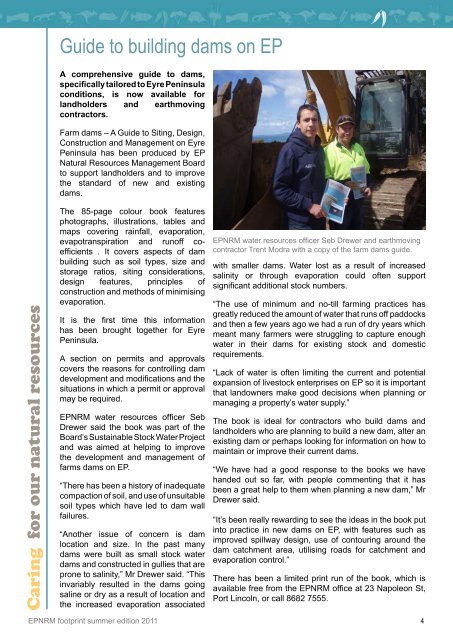The Footprint 2011 Summer Edition - Eyre Peninsula Natural ...
The Footprint 2011 Summer Edition - Eyre Peninsula Natural ...
The Footprint 2011 Summer Edition - Eyre Peninsula Natural ...
You also want an ePaper? Increase the reach of your titles
YUMPU automatically turns print PDFs into web optimized ePapers that Google loves.
Guide to building dams on EP<br />
A comprehensive guide to dams,<br />
specifically tailored to <strong>Eyre</strong> <strong>Peninsula</strong><br />
conditions, is now available for<br />
landholders and earthmoving<br />
contractors.<br />
Farm dams – A Guide to Siting, Design,<br />
Construction and Management on <strong>Eyre</strong><br />
<strong>Peninsula</strong> has been produced by EP<br />
<strong>Natural</strong> Resources Management Board<br />
to support landholders and to improve<br />
the standard of new and existing<br />
dams.<br />
Caring for our natural resources<br />
<strong>The</strong> 85-page colour book features<br />
photographs, illustrations, tables and<br />
maps covering rainfall, evaporation,<br />
evapotranspiration and runoff coefficients<br />
. It covers aspects of dam<br />
building such as soil types, size and<br />
storage ratios, siting considerations,<br />
design features, principles of<br />
construction and methods of minimising<br />
evaporation.<br />
It is the first time this information<br />
has been brought together for <strong>Eyre</strong><br />
<strong>Peninsula</strong>.<br />
A section on permits and approvals<br />
covers the reasons for controlling dam<br />
development and modifications and the<br />
situations in which a permit or approval<br />
may be required.<br />
EPNRM water resources officer Seb<br />
Drewer said the book was part of the<br />
Board’s Sustainable Stock Water Project<br />
and was aimed at helping to improve<br />
the development and management of<br />
farms dams on EP.<br />
“<strong>The</strong>re has been a history of inadequate<br />
compaction of soil, and use of unsuitable<br />
soil types which have led to dam wall<br />
failures.<br />
“Another issue of concern is dam<br />
location and size. In the past many<br />
dams were built as small stock water<br />
dams and constructed in gullies that are<br />
prone to salinity,” Mr Drewer said. “This<br />
invariably resulted in the dams going<br />
saline or dry as a result of location and<br />
the increased evaporation associated<br />
EPNRM water resources officer Seb Drewer and earthmoving<br />
contractor Trent Modra with a copy of the farm dams guide.<br />
with smaller dams. Water lost as a result of increased<br />
salinity or through evaporation could often support<br />
significant additional stock numbers.<br />
“<strong>The</strong> use of minimum and no-till farming practices has<br />
greatly reduced the amount of water that runs off paddocks<br />
and then a few years ago we had a run of dry years which<br />
meant many farmers were struggling to capture enough<br />
water in their dams for existing stock and domestic<br />
requirements.<br />
“Lack of water is often limiting the current and potential<br />
expansion of livestock enterprises on EP so it is important<br />
that landowners make good decisions when planning or<br />
managing a property’s water supply.”<br />
<strong>The</strong> book is ideal for contractors who build dams and<br />
landholders who are planning to build a new dam, alter an<br />
existing dam or perhaps looking for information on how to<br />
maintain or improve their current dams.<br />
“We have had a good response to the books we have<br />
handed out so far, with people commenting that it has<br />
been a great help to them when planning a new dam,” Mr<br />
Drewer said.<br />
“It’s been really rewarding to see the ideas in the book put<br />
into practice in new dams on EP, with features such as<br />
improved spillway design, use of contouring around the<br />
dam catchment area, utilising roads for catchment and<br />
evaporation control.”<br />
<strong>The</strong>re has been a limited print run of the book, which is<br />
available free from the EPNRM office at 23 Napoleon St,<br />
Port Lincoln, or call 8682 7555.<br />
EPNRM footprint summer edition <strong>2011</strong> 4

















